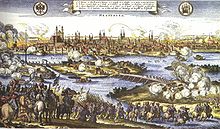In Walde fur Magdeborgk, Alda Ist vnser haubtman, fur eine schannse todt, nebhen Ihrer viel, geschossen worden. [..] den 20 Meige, haben wir mit ernst angesedtzet vndt gesturmet vndt auch erobert, da bin Ich mit sturmer handt ohn allen schaden, In die stadt kommen. Aber in die stadt am neistadter tohr bin Ich 2 Mal durch den leieb geschossen worden das Ist meine beute gewesen. [..] Nachher bin Ich In das leger gefuhret worden, verbunden, den einmal, bin Ich durch den bauch, forne durch geschossen, zum andern durch beide agslen, dass die Kugel, Ist In das hembte gelehgen, Also hat mir der feldtscher, die hende auff den Rugken gebunden, das er hat können Meissel, einbringen, Also bin Ich In meiner hudten gebracht worden, halb todt. [..] wie Ich nun verbunden bin, Ist mein weieb In die Stadt gegangen, da sie doch vber all gebrunnen hat [..] Auff den Abendt sindt nun meine gespan kommen, hat mir ein leder edtwas verehret, einen tall oder halben tall. | In the woods of Magedeburg, there our captain was shot dead for one of the entrenchments of the many there were. [..] on the 20th of May we earnestly engaged and stormed and also seized, there I came into town with storming hand without scathe. But in the town at the Newtown Gate I was shot two times in the body as this was my loot. [..] Later I was led into the camp, bandaged, for one I was shot in the stomach, and for the other through both axels that the bullet laid in the shirt. So the feldscher (army surgeon) bound my hands on the back so that he could insert the chisel (forceps). As that I was brought back to my shelter half dead. [..] As I was bandaged, my wife went into the town even that it was burning all over. [..] In the evening (it was that) my companions came and each of them bestowed me something, a thaler or half a thaler. |


